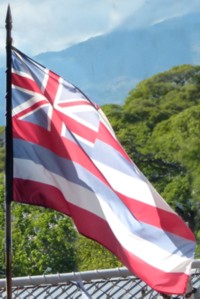Coup and Annexation
In January 1893 the Cruiser USS Boston was in Honolulu Harbor and her captain was being entertained by the US Government Minister (and Envoy Extraordinary) to the Kingdom, John Leavitt Stevens and local businessmen from the Committee of Safety.
Stevens had been a journalist and was an advocate of the doctrine of 'Manifest Destiny' that had been used to justify the seizing of Indian territory and the westward flow of settlers in the US. Later it would justify the extension of American power across the Pacific to Japan (Read More...) and the Philippines.
Advocates believed that Divine Providence had set America the task of spreading their founding beliefs, democratic institutions and technologies across the continent and then outwards to the world. Like The Blues Brothers, they were on a mission from God. Similar 'manifest destinies' would later be claimed by International Communism and by the Nazis under the doctrine of Lebensraum.
So in that American 'can do ' spirit and after a couple of drinks, on the afternoon of January 16 Stevens directed the captain of the Boston to provide 162 armed sailors and Marines to come ashore and support the local militia of the Committee of Safety as they deposed the Queen, raised the US flag and declared the Republic of Hawaii.
When news of the coup reached President Cleveland's administration in Washington an enquiry was initiated. It concluded that the monarchy had been illegally overthrown by force with the complicity of a United States Minister. Cleveland's State of the Union address included the statement: "Upon the facts developed it seemed to me the only honorable course for our Government to pursue was to undo the wrong that had been done by those representing us and to restore as far as practicable the status existing at the time of our forcible intervention." Thus the US would emulate the British restoration of 1843.
Yet the provisional government refused to step down. Instead they formally established the 'Republic of Hawai'i ' on US Independence Day, July 4, 1894, with Sanford Dole, a missionary descendent, as President. They then sat back to await forcible intervention by the United States to restore the Monarchy.
The following year an attempt was made by Hawaiian monarchists to restore the Queen but it was put down with extreme prejudice and she was put under house arrest. To get an amnesty for arrested loyalists she relinquished her claim to the throne. Japan protested both the overthrow and the brutality with which the counter revolution was put down. The Monarchy had the support of the most Japanese Hawaiians who were among those opposing increasing US influence. Might Japan attempt to invade? Might that, possibly invented threat, force the US to support the rogue Republic?
Meanwhile sugar prices had collapsed when the US opened its markets to other producers - making the reciprocity agreement worthless. The economy was in ruins.
The golden days of sugar were gone but soon other crops like macadamias from Australia and pineapples from South America would take its place. The Dole name, after cousins of Stanford, would become famous for fruit worldwide.
Three years after President Cleveland had threatened to restore the Monarchy the illegal Republic's luck changed for the better.
In 1898 the sinking of the Maine in Havana triggered the Spanish-American War and high on the new President McKinley's list of Spanish assets to seize, supposedly in reprisal for one ship, was the entire country of the Philippines. Now the United States would need a naval base from which to extend US naval power across the Pacific.
The long sought Annexation was promptly put into effect and to hell with lingering doubts over legality. Just days after Annexation the first US troops arrived. Hawaii became a territory of the US and the miscreant Sanford Dole its first Governor.
Camp McKinley August 16 1898 - 4 days after Annexation - US Army Museum

